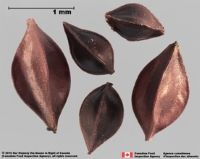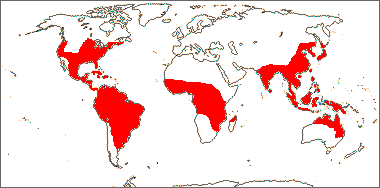Family name: Pontederiaceae K. Kunth
Synonym(s): Heterantheraceae J. Agardh
Common name(s): water-hyacinth family
*Number of genera/species: 6/34
List of genera records in GRIN-Global
fruit or seed
Fruit a loculicidalloculicidal:
type of capsular dehiscence, opening longitudinally through the locules (compare septicidal)
 capsulecapsule:
capsulecapsule:
a dry, dehiscent fruit derived from a compound ovary , sometimes a utricle or acheneachene:
, sometimes a utricle or acheneachene:
a dry, indehiscent, one-seeded fruit, with seed attached to pericarp at a single point, derived from a single, superior, simple or compound, one-loculed ovary , 1–18 mm long, linearlinear:
, 1–18 mm long, linearlinear:
(shape) long, narrow, and uniform in width; (of embryo) embryo is straight and much longer than wide to trigonoustrigonous:
to trigonoustrigonous:
3D shape—having three faces that meet at distinct angles; triangular in outline
, angledangular:
2D shape—having sides that meet at acute or obtuse angles
in transection, stylar remnantsstyle base:
remnant of a style persistent, sometimes winged, with one seed (Pontederia, Reussia) or many seeds. Pericarppericarp:
persistent, sometimes winged, with one seed (Pontederia, Reussia) or many seeds. Pericarppericarp:
fruit wall or fruit coat
brown, membranousmembranous:
texture—extremely thin, pliable, and fairly tough
, chartaceouschartaceous:
papery, papyraceous
, or indurateindurate:
texture—hardened or stony; yielding under strong pressure; not deformable without internal structural disruption
, ridgedridged:
surface relief—raised, thick ridges, sharp edged or rounded, usually in a series that may cover the entire surface . Fruits are often shed before they open with seeds maturing in capsulescapsule:
. Fruits are often shed before they open with seeds maturing in capsulescapsule:
a dry, dehiscent fruit derived from a compound ovary submerged in water. In Pontederia and Reussia, achenesachene:
submerged in water. In Pontederia and Reussia, achenesachene:
a dry, indehiscent, one-seeded fruit, with seed attached to pericarp at a single point, derived from a single, superior, simple or compound, one-loculed ovary are surrounded by accrescentaccrescent:
are surrounded by accrescentaccrescent:
growing continuously
tepals that are hardened and ridgedridged:
surface relief—raised, thick ridges, sharp edged or rounded, usually in a series that may cover the entire surface , sometimes spinyspiny:
, sometimes spinyspiny:
having slender, stiff, sharp projections oriented in the general plane of the structure .
.
Seeds globoseglobose:
3D shape—more or less spherical to reniformreniform:
to reniformreniform:
2D or 3D shape—kidney-shaped , tereteterete:
, tereteterete:
approximately circular in cross section; width and thickness approximately equal
 in transection, 0.5–2.1 mm long. Seed coat brown, thin, smooth. In seeds from genera with capsulescapsule:
in transection, 0.5–2.1 mm long. Seed coat brown, thin, smooth. In seeds from genera with capsulescapsule:
a dry, dehiscent fruit derived from a compound ovary , the seed coats are usually longitudinally ribbedribbed:
, the seed coats are usually longitudinally ribbedribbed:
surface relief—wide, prominent, linear ridges that are generally rounded and longitudinally situated on the surface to winged, and sometimes the funiculifuniculus:
to winged, and sometimes the funiculifuniculus:
(alt. funicle) stalk connecting the ovule (later seed) to the ovary (later fruit) placenta are persistent.
are persistent.
Embryo well developed, cylindricalcylindrical:
3D shape—a cylinder, with parallel sides and a circular cross-section; tubular or rod-shaped
, straight, length of seed or nearly so.
Endosperm copious, mealymealy:
loose, dry, and disintegrating in finely granular
pieces like meal or flour
.
Noxious Weed: USA Federal Noxious Weed List, aquatic, Eichhornia azurea (Sw.) Kunth, Monochoria hastata (L.) Solms-Laubach, and Monochoria vaginalis (Burman f.) C. Presl.
Federal Noxious Weed Disseminules of the US tool provides descriptions and images of these species. Aquarium & Pond Plants of the World tool also includes descriptions and images of other species in this family, which may be encountered.
Weedy and often considered invasive, growing gregariously in pools, ditches, rice fields, and wetlands. Spreads by seed, stolon reproduction, or rhizome propagation.
| Fruit | |
| Type | capsulecapsule: a dry, dehiscent fruit derived from a compound ovary  , utricleutricle: , utricleutricle:a small, indehiscent, dry fruit with a thin wall (bladderlike) that is loose and free from the seed, derived from a single, superior, simple ovary  , acheneachene: , acheneachene:a dry, indehiscent, one-seeded fruit, with seed attached to pericarp at a single point, derived from a single, superior, simple or compound, one-loculed ovary  |
| Size range | 1–18 mm long |
| Shape(s) | ovoidovoid: 3D shape—ovate  , oblongoblong: , oblongoblong:2D shape—much longer than broad with nearly parallel sides, corners are rounded  , linearlinear: , linearlinear:(shape) long, narrow, and uniform in width; (of embryo) embryo is straight and much longer than wide  , fusiformfusiform: , fusiformfusiform:spindle-shaped; broadest at the middle and tapering at both ends  , trigonoustrigonous: , trigonoustrigonous:3D shape—having three faces that meet at distinct angles; triangular in outline , ellipsoidellipsoid: 3D shape—elliptic , globoseglobose: 3D shape—more or less spherical  , teardrop-shapedteardrop-shaped: , teardrop-shapedteardrop-shaped:2D shape—widest point is toward one end of the fruit, the other end tapers sharply to a pointed end  |
| Texture | membranousmembranous: texture—extremely thin, pliable, and fairly tough , chartaceouschartaceous: papery, papyraceous , indurateindurate: texture—hardened or stony; yielding under strong pressure; not deformable without internal structural disruption |
| Surface relief | ridgedridged: surface relief—raised, thick ridges, sharp edged or rounded, usually in a series that may cover the entire surface  |
| Color(s) | brown |
| Seed | |
| Size range | 0.5–2.1 mm long |
| Shape(s) | ovoidovoid: 3D shape—ovate  , reniformreniform: , reniformreniform:2D or 3D shape—kidney-shaped  , oblongoblong: , oblongoblong:2D shape—much longer than broad with nearly parallel sides, corners are rounded  , ellipsoidellipsoid: , ellipsoidellipsoid:3D shape—elliptic , globoseglobose: 3D shape—more or less spherical  |
| Surface relief | ribbedribbed: surface relief—wide, prominent, linear ridges that are generally rounded and longitudinally situated on the surface  , ridgedridged: , ridgedridged:surface relief—raised, thick ridges, sharp edged or rounded, usually in a series that may cover the entire surface  , reticulatereticulate: , reticulatereticulate:surface relief—netted, raised walls or concave grooves forming a net-like surface pattern with flat, concave, or convex interspaces  , striatestriate: , striatestriate:surface relief—having fine, parallel lines, grooves or ridges  |
| Color(s) | brown |
| Unique features | Seeds small, longitudinally ribbedribbed: surface relief—wide, prominent, linear ridges that are generally rounded and longitudinally situated on the surface  to winged with relatively large embryo. to winged with relatively large embryo. |
| Other | |
| Embryo | well developed, cylindricalcylindrical: 3D shape—a cylinder, with parallel sides and a circular cross-section; tubular or rod-shaped , straight, length of the seed |
| Nutritive tissue | endosperm copious, mealymealy: loose, dry, and disintegrating in finely granular pieces like meal or flour |
Tropics, with a few members in warm-temperate regions.

Distribution map courtesy of Angiosperm Phylogeny Website.
Baskin and Baskin 2021Baskin and Baskin 2021:
Baskin C and Baskin J. 2021. Relationship of the lateral embryo (in grasses) to other monocot embryos: A status up-grade. Seed Science Research 31 (3): 199-210. doi:10.1017/S0960258521000209; Dahlgren et al. 1985Dahlgren et al. 1985:
Dahlgren RMT, Clifford HT, and Yeo PF. 1985. The families of the monocotyledons: structure, evolution, and taxonomy. Springer-Verlag, Berlin. 520 pp.; Flora of Australia 2021+Flora of Australia 2021+:
Flora of Australia. Australian Biological Resources Study, Canberra. Accessed January 2021–March 2024. URL: http://www.ausflora.org.au; Flora of North America Editorial Committee 1993+Flora of North America Editorial Committee 1993+:
Flora of North America Editorial Committee, eds. 1993+. Flora of North America North of Mexico [Online]. 22+ vols. Flora of North America Association, New York and Oxford. Accessed January-March 2024. URL: http://beta.floranorthamerica.org.; Kirkbride et al. 2006Kirkbride et al. 2006:
Kirkbride JH, Jr, Gunn CR, and Dallwitz MJ. 2006. Family guide for fruits and seeds, vers. 1.0. Accessed September 2020-January 2022. URL: https://nt.ars-grin.gov/seedsfruits/keys/frsdfam/index.cfm .; Kubitzki et al. 1990+Kubitzki et al. 1990+:
Kubitzki K et al., eds. 1990+. The families and genera of vascular plants. 7+ vols. Berlin etc.; Pellegrini et al. 2018Pellegrini et al. 2018:
Pellegrini MOO, Horn CN, and Almeida RF. 2018. Total evidence phylogeny of Pontederiaceae (Commelinales) sheds light on the necessity of its recircumscription and synopsis of Pontederia L. PhytoKeys 83 (108): 25-83. https://doi.org/10.3897/phytokeys.108.27652; Verdcourt 1968Verdcourt 1968:
Verdcourt B. 1968. Pontederiaceae. In: Milne-Redhead E and Polhill RM, eds. Flora of Tropical East Africa. Vol 149. Crown Agents for Oversea Governments and Administrations, London UK. 8 pp.; Zhengyi et al. 2004+Zhengyi et al. 2004+:
Zhengyi W, Raven PH, and Deyuan H. 2004+. Flora of China [online]. 25 vols. Science Press, Beijing China & Missouri Botanical Garden, St. Louis USA. Accessed January–March 2024. http://flora.huh.harvard.edu/china/; Zomlefer 1994Zomlefer 1994:
Zomlefer WB. 1994. Guide to Flowering Plant Families. The University of North Carolina Press, Chapel Hill. 430 pp.
*The number of genera and species is based on Christenhusz and Byng 2016Christenhusz and Byng 2016:
Christenhusz MJM and Byng JW. 2016. The number of known plant species in the world and its annual increase. Phytotaxa 261 (3): 201-217. https://doi.org/10.11646/phytotaxa.261.3.1, which may differ from the number of genera in GRIN-Global.